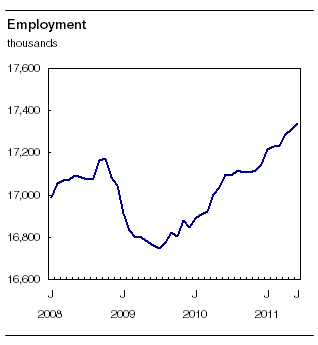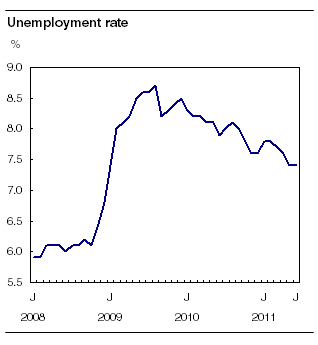Labour Force Survey
Archived Content
Information identified as archived is provided for reference, research or recordkeeping purposes. It is not subject to the Government of Canada Web Standards and has not been altered or updated since it was archived. Please "contact us" to request a format other than those available.
Related subjects
-
[an error occurred while processing this directive]
Employment rose for the third consecutive month, up 28,000 in June. The unemployment rate was unchanged at 7.4% as the number of people participating in the labour market increased. Over the past 12 months, employment has grown by 238,000 (+1.4%).

Employment was up in transportation and warehousing in June, while it fell in professional, scientific and technical services. There was little change in the other industries.
Increases in the number of employees working in the public and private sectors were tempered by a decline in the number of self-employed. Over the past 12 months, public sector employment rose by 2.5%, private sector employment was up 1.5%, while the number of self-employed was little changed.
Ontario, Alberta and Nova Scotia posted employment gains in June, while there were declines in Quebec as well as Newfoundland and Labrador. Employment was little changed in the other provinces.
The bulk of June's employment increase occurred among women aged 25 to 54.
Compared with 12 months earlier, the unemployment rate for students aged 17 to 19 was down in June, while it was little changed for students aged 20 to 24.

Description: Unemployment rate
Note to readers
Labour Force Survey (LFS) estimates are based on a sample, and are therefore subject to sampling variability. Estimates for smaller geographic areas or industries will have more variability. For an explanation of sampling variability of estimates, and how to use standard errors to assess this variability, consult the "Data quality" section of the publication Labour Force Information (71-001-X, free).
Unless otherwise stated, this release presents seasonally adjusted data, which facilitates comparisons by removing the effects of seasonal variations.
Gains in transportation and warehousing
Employment rose by 15,000 in transportation and warehousing in June. Since June 2010, this industry experienced the fastest employment growth of all industries at 5.4% (+43,000).
Following steady growth since the start of 2011, employment in professional, scientific and technical services was down 19,000 in June. Compared with 12 months earlier, employment in the industry is up 1.3% (+16,000).
For the third consecutive month, employment in construction was little changed. However, the number of people working in this industry has increased by 3.2% (+39,000) since June 2010.
Manufacturing employment was little changed in June, following a decline in May. Over the past 12 months, employment in this industry has risen by 30,000 or 1.7%, slightly faster than the pace of overall employment growth (+1.4%).
Public sector adds employees while self-employment declines
The number of employees in the public sector rose by 51,000 in June, while it was up 22,000 in the private sector. At the same time, the number of self-employed fell by 44,000.
Over the past 12 months, employment has grown 2.5% in the public sector (+87,000). Over the same period, private sector employment increased by 1.5% (+159,000), while the number of self-employed was little changed.
Part-time work accounted for much of the monthly increase in June. Over the past 12 months, however, growth in full time contributed 205,000 of the 238,000 increase in overall employment.
Ontario and Alberta drive employment gains
Employment in Ontario was up 40,000 in June, following a slight decline in May. Over the past 12 months, employment in the province increased 114,000 (+1.7%), almost entirely in full-time work. The unemployment rate fell by 0.2 percentage points in June to 7.7%.
In Alberta, employment rose by 22,000. At the same time, the unemployment rate edged up to 5.6%, as there were more people looking for work. Employment in the province continued on its upward trend, growing by 3.5% between June 2010 and June 2011, more than twice the national pace of growth (+1.4%).
Nova Scotia also posted employment gains in June, up 3,800. Despite this gain, employment in the province is down 0.8% over the past 12 months.
Employment in Quebec fell by 16,000, mostly among 15- to 24-year-olds. An increase in the number of people looking for work pushed the unemployment rate up 0.6 percentage points to 7.9%.
Newfoundland and Labrador also experienced a decline in employment in June, down 7,400. Nevertheless, employment in the province was 2.4% above the level of June 2010.
Employment growth primarily among core-aged women
Employment rose by 28,000 among core-aged women (25 to 54 years) in June, while it held steady among the other demographic groups.
Compared with 12 months earlier, employment increased at the fastest pace among workers aged 55 and over, with growth of 5.4% (+71,000) among women and 4.0% (+64,000) among men. Over the same period, employment among core-aged men increased by 1.3% (+79,000), while it was little changed for core-aged women and youths.
Student summer employment
From May to August, the Labour Force Survey collects labour market information about young people aged 15 to 24 who were attending school full time in March and intend to return to school in the fall. The May and June survey results provide the first indicators of the summer job market, while the July and August data will provide further insight. The published estimates are not seasonally adjusted; therefore, comparisons can only be made on a year-over-year basis.
For students aged 20 to 24, the employment rate was little changed at 67.4% in June compared with June 2010. However, this rate was 4.2 percentage points above their rate in June 2009, a time when the student job market was particularly affected by the labour market downturn. The unemployment rate of 11.0% for these students was little changed in June compared with June 2010.
In June, the employment rate for 17- to 19-year-old students was 53.8%, slightly above their rates in both June 2010 and June 2009. Their unemployment rate fell 2.2 percentage points to 13.8% in June compared with June 2010.
Quarterly update on the territories
The Labour Force Survey also collects labour market information about the territories. This information is produced monthly in the form of three-month moving averages. Not all estimates are seasonally adjusted, therefore comparisons should only be made on a year-over-year basis.
All three territories saw employment gains in the second quarter compared with the same quarter of 2010.
In Yukon, employment increased by 1,700 (+9.7%) in the second quarter compared with the same quarter in 2010. At the same time, the unemployment rate declined by 1.6 percentage points to 6.3%.
Employment in the Northwest Territories rose by 1,000 (+4.6%) from the second quarter of 2010 to the second quarter in 2011. The unemployment rate was little changed at 8.1%.
In Nunavut, employment increased by 500 (+4.4%) in the second quarter compared with the second quarter of 2010. The unemployment rate was 16.6%, 2.6 percentage points lower than the same quarter of 2010.
Available on CANSIM: tables 282-0001 to 282-0042, 282-0047 to 282-0063, 282-0069 to 282-0095 and 282-0100 to 282-0121.
Definitions, data sources and methods: survey number 3701.
A more detailed summary, Labour Force Information (71-001-X, free) is now available online for the week ending June 18. From the Key resource module of our website under Publications, choose All subjects, then Labour. LAN and bulk prices are available on request. The DVD-ROM Labour Force Historical Review, 2010 (71F0004X, $209) is now available. See How to order products.
Data tables are also now available online. From the Subject module of our website, choose Labour.
The next release of the Labour Force Survey will be on August 5.
For general information or to order data, contact Client Services (toll-free 1-866-873-8788; 613-951-4090; labour@statcan.gc.ca). To enquire about the concepts, methods or data quality of this release, contact Danielle Zietsma (613-951-4243; danielle.zietsma@statcan.gc.ca) or Vincent Ferrao (613-951-4750; vincent.ferrao@statcan.gc.ca), Labour Statistics Division.
- Date modified:
